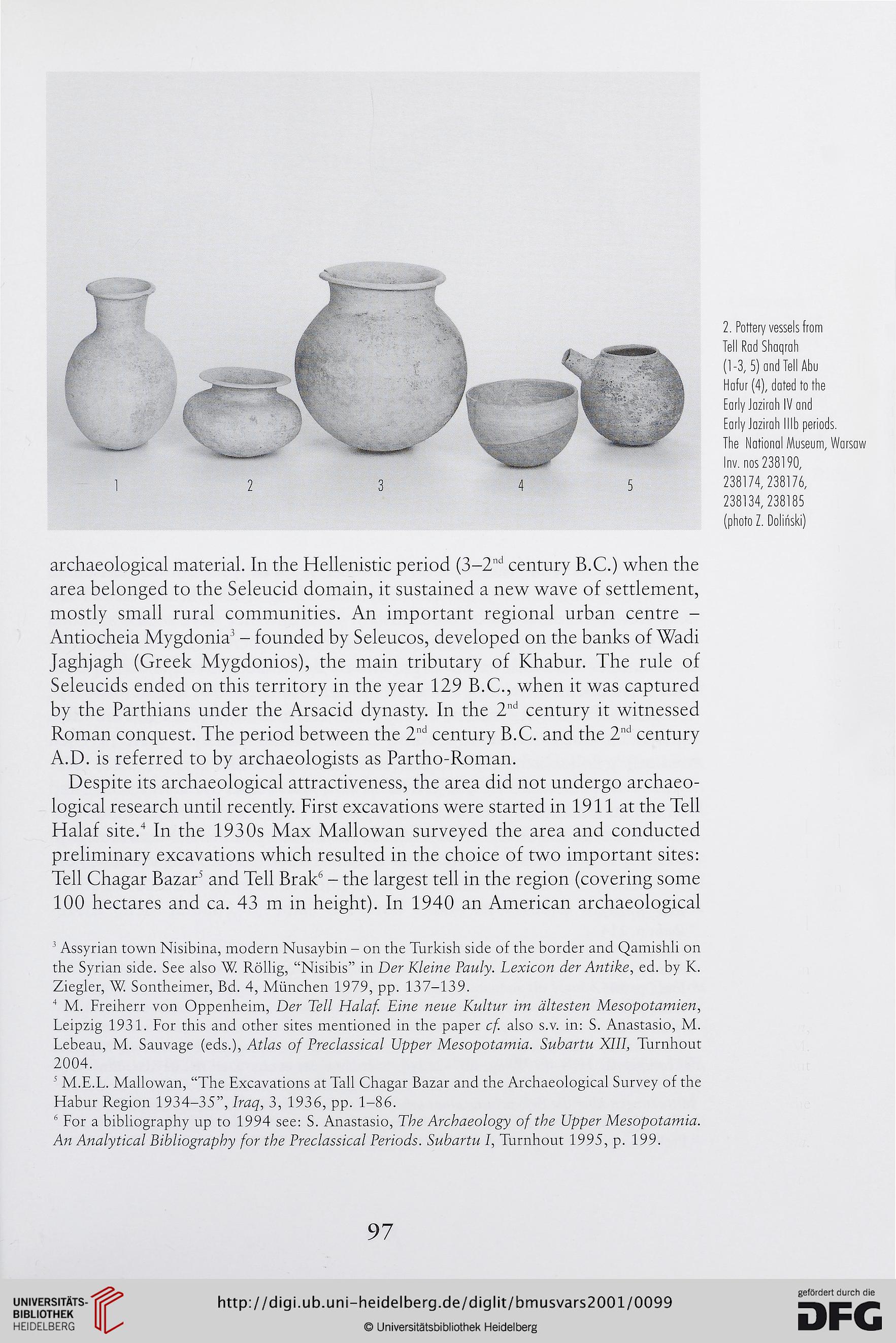2. Pottery vessels from
Tell Rad Shaqrah
(1-3,5) and Tell Abu
Hafur (4), dated to the
Early Jazirah IV and
Early Jazirah lllb periods.
The National Museum, Warsaw
lnv. nos 238190,
238174, 238176,
238134, 238185
(photo Z. Doliński)
archaeological materiał. In the Hellenistic period (3-2nd century B.C.) when the
area belonged to the Seleucid domain, it sustained a new wave of settlement,
mostly smali rural communities. An important regional urban centre -
Antiocheia Mygdonia3 - founded by Seleucos, developed on the banks of Wadi
Jaghjagh (Greek Mygdonios), the main tributary of Khabur. The rule of
Seleucids ended on this territory in the year 129 B.C., when it was captured
by the Parthians under the Arsacid dynasty. In the 2nd century it witnessed
Roman conąuest. The period between the 2nd century B.C. and the 2nd century
A.D. is referred to by archaeologists as Partho-Roman.
Despite its archaeological attractiveness, the area did not undergo archaeo-
logical research until recently. First excavations were started in 1911 at the Tell
Halaf site.4 5 In the 193Os Max Mallowan surveyed the area and conducted
preliminary excavations which resulted in the choice of two important sites:
Tell Chagar Bazar1 and Tell Brak6 * - the largest tell in the region (covering some
100 hectares and ca. 43 m in height). In 1940 an American archaeological
3 Assyrian town Nisibina, modern Nusaybin - on the Turkish side of the border and Qamishli on
the Syrian side. See also W Rollig, “Nisibis” in Der Kleine Pauly. Lexicon der Antike, ed. by K.
Ziegler, W. Sontheimer, Bd. 4, Miinchen 1979, pp. 137-139.
4 M. Freiherr von Oppenheim, Der Tell Halaf. Eine neue Kultur im altesten Mesopotamien,
Leipzig 1931. For this and other sites mentioned in the paper cf. also s.v. in: S. Anastasio, M.
Lebeau, M. Sauvage (eds.), Atlas of Preclassical Upper Mesopotamia. Subartu XIII, Turnhout
2004.
5 M.E.L. Mallowan, “The Excavations at Tali Chagar Bazar and the Archaeological Survey of the
Habur Region 1934-35”, Iraq, 3, 1936, pp. 1-86.
6 For a bibliography up to 1994 see: S. Anastasio, The Archaeology of the Upper Mesopotamia.
An Analytical Bibliography for the Preclassical Periods. Subartu I, Turnhout 1995, p. 199.
97
Tell Rad Shaqrah
(1-3,5) and Tell Abu
Hafur (4), dated to the
Early Jazirah IV and
Early Jazirah lllb periods.
The National Museum, Warsaw
lnv. nos 238190,
238174, 238176,
238134, 238185
(photo Z. Doliński)
archaeological materiał. In the Hellenistic period (3-2nd century B.C.) when the
area belonged to the Seleucid domain, it sustained a new wave of settlement,
mostly smali rural communities. An important regional urban centre -
Antiocheia Mygdonia3 - founded by Seleucos, developed on the banks of Wadi
Jaghjagh (Greek Mygdonios), the main tributary of Khabur. The rule of
Seleucids ended on this territory in the year 129 B.C., when it was captured
by the Parthians under the Arsacid dynasty. In the 2nd century it witnessed
Roman conąuest. The period between the 2nd century B.C. and the 2nd century
A.D. is referred to by archaeologists as Partho-Roman.
Despite its archaeological attractiveness, the area did not undergo archaeo-
logical research until recently. First excavations were started in 1911 at the Tell
Halaf site.4 5 In the 193Os Max Mallowan surveyed the area and conducted
preliminary excavations which resulted in the choice of two important sites:
Tell Chagar Bazar1 and Tell Brak6 * - the largest tell in the region (covering some
100 hectares and ca. 43 m in height). In 1940 an American archaeological
3 Assyrian town Nisibina, modern Nusaybin - on the Turkish side of the border and Qamishli on
the Syrian side. See also W Rollig, “Nisibis” in Der Kleine Pauly. Lexicon der Antike, ed. by K.
Ziegler, W. Sontheimer, Bd. 4, Miinchen 1979, pp. 137-139.
4 M. Freiherr von Oppenheim, Der Tell Halaf. Eine neue Kultur im altesten Mesopotamien,
Leipzig 1931. For this and other sites mentioned in the paper cf. also s.v. in: S. Anastasio, M.
Lebeau, M. Sauvage (eds.), Atlas of Preclassical Upper Mesopotamia. Subartu XIII, Turnhout
2004.
5 M.E.L. Mallowan, “The Excavations at Tali Chagar Bazar and the Archaeological Survey of the
Habur Region 1934-35”, Iraq, 3, 1936, pp. 1-86.
6 For a bibliography up to 1994 see: S. Anastasio, The Archaeology of the Upper Mesopotamia.
An Analytical Bibliography for the Preclassical Periods. Subartu I, Turnhout 1995, p. 199.
97




